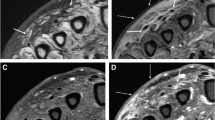Abstract
Ustilago, a common fungal parasite of grains, is infrequently isolated as a pathogen in humans. We describe a case of Ustilago echinata infection following an open distal tibia fracture, review the current literature of this genus as a cause of invasive fungal infection in humans, and discuss management issues.

Similar content being viewed by others
References
Romanelli AM, Sutton DA, Thompson EH, Rinaldi MG, Wickes BL. Sequence-based identification of filamentous basidiomycetous fungi from clinical specimens: a cautionary note. J Clin Microbiol. 2010;48:741–52.
White TJ, Bruns TD, Lee SB, Taylor JW. Amplification and direct sequencing of fungal ribosomal RNA genes for phylogenetics. In: Innis MA, Gelfand DH, Sninsky JJ, White TJ, editors. PCR protocols: a guide to methods and applications. New York: Academic Press Inc; 1990. p. 315–22.
Kamper J, Kahmann R, Bolker M, et al. Insights from the genome of the biotrophic fungal plant pathogen Ustilago maydis. Nature. 2006;444:97–101.
Weber RW, Levetin E. Allergen of the month-Ustilago maydis. Ann Allergy Asthma Immunol. 2013;111:A13.
Singh AB, Kumar P. Common environmental allergens causing respiratory allergy in India. Indian J Pediatr. 2002;69:245–50.
Teo LH, Tay YK. Ustilago species infection in humans. Br J Dermatol. 2006;155:1096–7.
McGhie TA, Huber TW, Kassis CE, Jinadatha C. Ustilago species as a cause of central line-related blood stream infection. Am J Med Sci. 2013;345:254–5.
Patel R, Roberts GD, Kelly DG, Walker RC. Central venous catheter infection due to Ustilago species. Clin Infect Dis. 1995;21:1043–4.
Moore M, Russell WO, Sachs E. Chronic leptomeningitis and ependymitis caused by Ustilago, probably U. zeae (corn smut). Am J Pathol. 1946;22:761–77.
Stoll M, Piepenbring M, Begerow D, Oberwinkler F. Molecular phylogeny of Ustilago and Sporisorium species (Basidiomyceta, Ustilaginales) based on internal transcribed spacer (ITS) sequences. Can J Bot. 2003;81:976–84.
Preininger T. Durch maisbrand (Ustilago maydis) bedingte dermatomykose. Arch f Dermat u Syph. 1937;176:109–13.
Author information
Authors and Affiliations
Corresponding author
Rights and permissions
About this article
Cite this article
Stewart, E., Waldman, S., Sutton, D.A. et al. Ustilago echinata: Infection in a Mixed Martial Artist Following an Open Fracture. Mycopathologia 181, 311–314 (2016). https://doi.org/10.1007/s11046-015-9967-1
Received:
Accepted:
Published:
Issue Date:
DOI: https://doi.org/10.1007/s11046-015-9967-1




